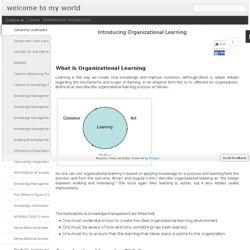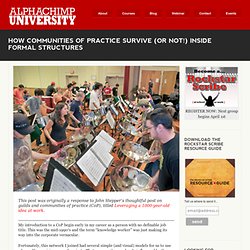

Introducing Organizational Learning. These views should be seen as complementary rather than contradictory.

The next two sub-sections will examine organizational learning theory from these two perspectives. Two of the most noteworthy contributors to the field of organizational learning theory have been Chris Argrys and Donald Schon.Organizational learning (OL), according to Argrys & Schon is a product of organizational inquiry. This means that whenever expected outcome differs from actual outcome, an individual (or group) will engage in inquiry to understand and, if necessary, solve this inconsistency. In the process of organizational inquiry, the individual will interact with other members of the organization and learning will take place.
Learning is therefore a direct product of this interaction. Argrys and Schon emphasize that this interaction often goes well beyond defined organizational rules and procedures. Espoused theory: This refers to the formalized part of the organization. Conclusion The Implications to KM. Rae - rae.pdf. How Communities of Practice Survive (or Not!) Inside Formal Structures. This post was originally a response to John Stepper’s thoughtful post on guilds and communities of practice (CoP), titled Leveraging a 1000-year-old idea at work.

My introduction to a CoP begin early in my career as a person with no definable job title. This was the mid-1990′s and the term “knowledge worker” was just making its way into the corporate vernacular. Fortunately, this network I joined had several simple (and visual) models for us to use when self-organizing around projects. That community was deeply influenced by the tradition of architecture as a mentor-apprentice education model; the Montessori school learning environment (in which teachers are “guides”); and Christopher Alexander’s “pattern language” philosophical work on why built environment live and die. This fear, whether warranted or not, is often magnified by the quarterly demands for ROI for any initiative. Communities of Practice and Pattern Language by James B. Photo via Humboldt State University on Flickr. People-centric approach to finding information. Collaboration Online. The Heaven and Hell of Communities & Networks.
Upskilling by Jane Bozarth. “It should have been part of our work all along to help the learners be better learners.”

New media has brought with it new challenges for instructional designers and facilitators. Where just five years ago we were still primarily concerned with things like authoring tools and content management, we now face new demands for making programs more inclusive of learners and building a farther reach for the L&D department.
This speaks to the need for new skills. While every designer won’t need to develop every skill, it’s important that you become familiar with most and, depending on your role, start working toward ways of building the new skills for yourself, or building new approaches into programs that others might facilitate or deliver. Paving informal paths Helping learners find one another and information they need is a new critical role for L&D. Curation. Inclusion. Participation. Community management. Want more? On curation, see Beth Kanter’s blog post “Content Curation 101”: Communities of practice enable the integration of work and learning.
At the Employee Advocacy Summit this afternoon, Jim Dudukovich, a lawyer from The Coca-Cola Company, gave us a rare glimpse into the world where social media and law intersect.

He brought simplicity and clarity to a number of issues that arise when planning an employee advocacy program. This is one of a series of posts recapping the day and key comments from speakers and guests. Speaker: Jim Dudukovich, Senior Marketing, Digital & Social Media Counsel, The Coca-Cola Company When creating an EA program, there will be a wide variety of legal issues that are going to arise. There are going to be issues with clear lines of distinction of what's possible for employees/employers to do, as well as those in a gray area. Legal Issues to Keep in Mind TransparencyFactual accuracyHonestyMandatory vs. optionalProtected activity Designing a Social Media Policy Social media policies can't be designed in a vacuum and can't be written it stone.
"Go to the scene. " Communities of practice enable the integration of work and learning. Communities of practice and social learning systems.